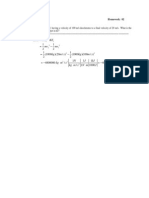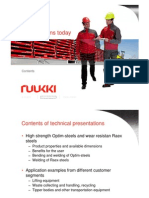HW 16 Solutions Spring 2012
HW 16 Solutions Spring 2012
Uploaded by
shaangakharCopyright:
Available Formats
HW 16 Solutions Spring 2012
HW 16 Solutions Spring 2012
Uploaded by
shaangakharCopyright
Available Formats
Share this document
Did you find this document useful?
Is this content inappropriate?
Copyright:
Available Formats
HW 16 Solutions Spring 2012
HW 16 Solutions Spring 2012
Uploaded by
shaangakharCopyright:
Available Formats
EGR 334 Thermodynamics: Homework 16
Problem 4:36
Methane (CH4) gas enters a horizontal well insulated nozzle operating at steady state at 80 deg. C and a velocity of
10 m/s. Assuming ideal gas behavior for the methane, plot the temperature of the gas exiting the nozzle in deg C
versus the exit velocity ranging from 500 to 600 m/s.
----------------------------------------------------------------------------------------------------------------------------- --------------
Methane as ideal gas
State 1: T
1
= 80 C= 353 K V
1
= 10 m/s
State 2: V
2
= 500 to 600 m/s
Energy Balance for a Nozzle at steady state:
2 2
0 ( ) ( )
2 2
i e
i i i e e e
V V
Q W m h gz m h gz = + + + + +
assuming: no work, no heat loss, constant elevation.
2 2
1 2 1 2
1
0 ( )
2
h h V V = +
Using ideal gas model:
2 2
1 2 1 2
1
0 ( ) ( )
2
p
c T T V V = +
2 2
2 1 1 2
1
( )
2
p
T T V V
c
= +
do unit check:
2
2
[ / ]
[ ] [ ]
[ / ] 1000 /
m s kJ N
K K
kJ kg K N m kg m s
= +
c
p
can be found from table A-21 where
2 3 4 p
c
T T T T
R
o | o c = + + + +
3 6 2 9 3 12 4
3.826 3.979 10 24.558 10 22.733 10 6.963 10
p
c
T T T T
R
= + +
4.59
p
c
R
=
4.59
p
c R =
where so
p
p
c
c
M
=
4.59(8.314 / ) 4.59
2.379 /
(16.04 / )
mol
p
mol
kJ k K R
c kJ kg K
M kg k
= = =
A plot of the T
2
vs V
2
is shown on the next page which was created using Excel:
Plot of T
2
vs. V
2
for nozzle.
or solved with IT
x
EGR 334 Thermodynamics: Homework 16
Problem 4:43
Air expands through a turbine from 8 bar, 960 K to 1 bar, 450 K. The inlet velocity is small compared to the exit
velocity of 90 m/s. The turbine operates at steady state and develops a power output of 2500 kW. Heat transfer
between the turbine and its surroundings and potential energy effects are negligible. Modeling air as an ideal gas,
calculate the mass flow rate of air in kg/s and the exit area in sq. m.
----------------------------------------------------------------------------------------------------------------------------- -----
Turbine using air as ideal gas
State 1: p
1
= 8 bar and T
1
= 960 K V
1
<< V
2
= 90 m/s
State 2: p
2
= 1 bar, and T
2
= 450 K
Turbine power =Wdot = 2500 kW Assume: Q = 0 and PE = 0
constants: use R = 0.2870 kJ/kg-K c
p
(@700K) = 1.075 kJ/kg-K
Using ideal gas:
State 1:
3 1
1 5 2
1
(0.2870 / )(960 ) 1000
0.344 /
(8 ) 10 /
RT kJ kg K K bar N m
v m kg
p bar N m kJ
= = =
State 2:
3 2
2 5 2
2
(0.2870 / )(450 ) 1000
1.2915 /
(1 ) 10 /
RT kJ kg K K bar N m
v m kg
p bar N m kJ
= = =
from the energy balance at steady state:
2 2
0 ( ) ( )
2 2
i e
i i i e e e
V V
Q W m h gz m h gz = + + + + +
Assume Q = 0 and PE = 0
2 2
1 2
1 2
0
2 2
V V W
h h
m
= + + +
2 2
1 2
1 2
2 2
V V W
h h
m
= + +
( )
2 2
1 2 1 2
1
( )
2
p
W
c T T V V
m
= +
( )
2 2
1 2 1 2
1
( )
2
p
W
m
c T T V V
=
+
( )
2 2
2
2500 /
4.59 /
1
(1.075 / )(960 450) 0 (90 / )
2 1000 /
kW kJ s
m kg s
kW kJ N
kJ kg K K m s
N m kg m s
(
(
(
= =
(
+
(
from the mass balance at steady state:
1 2
0 m m =
1 2
4.59 / m m kg s = =
Volumetric flow rate is given by
3 3
2 1
(4.59 / )(1.2915 / ) 5.93 / V m v kg s m kg m s = = =
and
2 2 2
V AV =
3
2 2
2
2
5.93 /
0.066
90 /
V m s
A m
V m s
= = =
EGR 334 Thermodynamics: Homework 16
Problem 4:52
Air enters a compressor operating at steady state at 1 atm with a specific enthalpy of 290 kJ/kg and exits at a higher
pressure with a specific enthalpy of 1023 kJ/kg. The mass flow rate is 0.1 kg/s. If the compressor power input is 77
kW, determine the rate of heat transfer between the compressor and its surroundings, in kW. Neglect kinetic and
potential energy effects and assume the ideal gas model.
------------------------------------------------------------------------------------------------------------------------------
Air at steady state as an ideal gas: mdot = 0.1 kg/s W
compressor in
= 77 kW
p
1
= 1 atm h
1
= 290 kJ/kg
p
2
> p
1
h
2
= 1023 kJ/kg
constants: use R = 0.2870 kJ/kg-K
Assume V
1
V
2
and PE = 0
for Air as ideal gas, T can be found from table A-22:
for h
1
= 290 kJ/kgT
1
= 289.8 K
h
2
= 1023kJ/kgT2 = 979.8 K
from the mass balance at steady state:
1 2
0 m m =
1 2
0.1 / m m kg s = =
from the energy balance at steady state:
2 2
0 ( ) ( )
2 2
i e
i i i e e e
V V
Q W m h gz m h gz = + + + + +
Assume V
1
V
2
and PE = 0
1 1 2 2
0 Q W m h m h = +
/
( 77 ) (0.1 / )(1023 290) / 3.7 / 3.7
kJ s
Q kW kg s kJ kg kJ s kW
kW
= + = =
EGR 334 Thermodynamics: Homework 16
Problem 4:66
The figure provides steady state operating data for a pump drawing water from a reservoir and delivering it at a
pressure of 3 bar to a storage tank perched above the reservoir. The mass flow rate of the water is 1.5 kg/s. The
water temperature remains nearly constant at 15 deg C, there is no significant change in kinetic energy from inlet to
exit and heat transfer between the pump and its surroundings is small. Determine the power required by the pump in
kW. Let g = 9.81 m/s
2
.
---------------------------------------------------------------------------------------------------------------------------------
State 1: T
1
= 15 C
p
1
= 1bar
z
1
= 0
state 2: T
2
= 15 C
p
2
= 3 bar
z
2
=15 m
Assume KE = 0 and Q = 0
Steady state:
from the mass balance at steady state:
1 2
0 m m =
1 2
m m =
from the energy balance at steady state:
2 2
0 ( ) ( )
2 2
i e
i i i e e e
V V
Q W m h gz m h gz = + + + + +
Assume Q = 0 and KE = 0 for liquid h
1
= h
2
= h
f
(T=15) if temperature is constant
1 2
0 ( ) W mg z z = +
2
1 2 2
( ) (1.5 / )(9.81 / )(0 15) 0.221
/ 1000 /
N kJ kW
W mg z z kg s m s m kW
kg m s N m kJ s
= = =
The work is negative since is done on the system which the work that needs to be done by the pump on the system:
0.221
pump pump
W W kW = =
Alternate solution: Using equation 3.13:
1 2
( ) ( )
i e
W m h h m g z z = +
where
{ } { }
1 2 1 2
( ) ( )[ ( )] ( ) ( )[ ( )]
f f sat f f sat
h h h T v T p p T h T v T p p T = + +
1 2 1 2
( )
f
h h v p p =
1 2
( ) ( )
f i e
W mv p p m g z z = +
5 2
3 2
2
10 / 1000
(1.5 / ) (0.0010009 / )(1 3) (9.81 / )(0 15) 521
1 / 1000 /
N m N kJ W
W kg s m kg bar m s m W
bar kg m s N m kJ s
= + =
`
)
= -0.521 kW
You might also like
- Avenger Schematics.1607720709Document13 pagesAvenger Schematics.1607720709Patricio Bacigalupi100% (4)
- Introduction To Chemical Processes Murphy Chapter06 SolutionsDocument94 pagesIntroduction To Chemical Processes Murphy Chapter06 SolutionsEric Barnett29% (7)
- Capitulo 12 StoeckerDocument11 pagesCapitulo 12 StoeckerPaulo Azañero75% (4)
- Mer 231 Steady Flow ExamplesDocument9 pagesMer 231 Steady Flow ExamplesOmar CorralNo ratings yet
- Homework 2Document8 pagesHomework 2jinx50100% (1)
- HWSolutions PDFDocument42 pagesHWSolutions PDFJames AhnNo ratings yet
- Tutorial Sheet 02 Answers 2014Document24 pagesTutorial Sheet 02 Answers 2014checkmeout803100% (1)
- Solution Tutorial 06-Fall-09Document5 pagesSolution Tutorial 06-Fall-09Amaliza90No ratings yet
- HW 5 SolnDocument7 pagesHW 5 SolnNik Hafiy HafiziNo ratings yet
- Thermo 5th Chap09 P132Document34 pagesThermo 5th Chap09 P132Ahmad AlgarniNo ratings yet
- Chap6 3Document10 pagesChap6 3robson_limeiraNo ratings yet
- Solution Week 9Document6 pagesSolution Week 9Ariadne ChuaNo ratings yet
- CH 13Document32 pagesCH 13hirenpatel_universalNo ratings yet
- Solution#4Document8 pagesSolution#4Vontrex DergonNo ratings yet
- Termo Isı 1011 Örnek4Document13 pagesTermo Isı 1011 Örnek4Şafak MeçoNo ratings yet
- HW 12 Solutions Spring 2012Document4 pagesHW 12 Solutions Spring 2012Pravallika KolliparaNo ratings yet
- Thermo 5th Chap10 P001Document29 pagesThermo 5th Chap10 P001welberTonetoMotaNo ratings yet
- Chapter 22 Solutions: e W Q Q W Q WDocument32 pagesChapter 22 Solutions: e W Q Q W Q Wysrra94No ratings yet
- Problems and SolutionsDocument37 pagesProblems and Solutionsalfrinjarj100% (2)
- Be Mechanical-Engineering Semester-3 2019 December Thermodynamics-CbcgsDocument14 pagesBe Mechanical-Engineering Semester-3 2019 December Thermodynamics-CbcgsHarsh KbddhsjNo ratings yet
- Chap5 4Document8 pagesChap5 4Christopher EvanNo ratings yet
- Felix Termodinamica Quimica ch03Document104 pagesFelix Termodinamica Quimica ch03Amilcar Pereira CardosoNo ratings yet
- HW5Document6 pagesHW5YTK96No ratings yet
- Engineering ThermodynamicsDocument10 pagesEngineering ThermodynamicsKumara VelanNo ratings yet
- Heat Chap13 095Document16 pagesHeat Chap13 095Kerem GönceNo ratings yet
- ME3122E - Tutorial Solution 3Document8 pagesME3122E - Tutorial Solution 3LinShaodun100% (3)
- ExergyDocument30 pagesExergyRooth Adajet100% (1)
- HW 02 Solutions Spring 2012Document6 pagesHW 02 Solutions Spring 2012shlaeaNo ratings yet
- Example CH 4Document4 pagesExample CH 4Uday Prakash SahuNo ratings yet
- hw3 4,563,587,567,575,593,687,698,6102,739,763,797Document11 pageshw3 4,563,587,567,575,593,687,698,6102,739,763,797megha_23No ratings yet
- Thermodynamics Worked ExamplesDocument13 pagesThermodynamics Worked ExamplesSalah Salman100% (2)
- Thermodyancs Chapter 9 Solution ManuelDocument36 pagesThermodyancs Chapter 9 Solution ManuelFarhad MojaverNo ratings yet
- Recitation 3 PDFDocument17 pagesRecitation 3 PDFOnur ÖZÇELİKNo ratings yet
- HW 10Document2 pagesHW 10hangman001No ratings yet
- Tutorial 9 Solutions 1Document5 pagesTutorial 9 Solutions 1Henry TranNo ratings yet
- Ciclo BraytonDocument17 pagesCiclo BraytonNubia Bergamini100% (3)
- Thermodynamics Advanced HomeWork 1Document11 pagesThermodynamics Advanced HomeWork 1فیضان قادرNo ratings yet
- Thermodynamics For Engineers SI Edition 1st Edition Kroos Solutions Manual 1Document55 pagesThermodynamics For Engineers SI Edition 1st Edition Kroos Solutions Manual 1Marcos Ecklund100% (47)
- Toaz - Info Ideal Gas 50 89docx PRDocument6 pagesToaz - Info Ideal Gas 50 89docx PRMark Aaron L. DellosaNo ratings yet
- Heat Chap02 068Document24 pagesHeat Chap02 068Kerem GönceNo ratings yet
- Thermo 5th Chap09 P101Document27 pagesThermo 5th Chap09 P101Ahmad AlgarniNo ratings yet
- Chap4 Closed SystemDocument17 pagesChap4 Closed SystemGerman MendiaNo ratings yet
- ThermodynamicsDocument79 pagesThermodynamicstixy2013No ratings yet
- ENGR 2213 ThermodynamicsDocument25 pagesENGR 2213 ThermodynamicsIgor MatosNo ratings yet
- Assignment 2 SolutionDocument31 pagesAssignment 2 SolutionSirish Chand Putla0% (1)
- Thermo ProblemsDocument8 pagesThermo ProblemsChrister John UyNo ratings yet
- ME3100 Solution Tut-2Document8 pagesME3100 Solution Tut-2B V V HANUMA GAYATHRINo ratings yet
- Solution of Assignment 3: Bar P K TDocument6 pagesSolution of Assignment 3: Bar P K TMohammad UsmanNo ratings yet
- Zeroth Law and Introductory ConceptsDocument13 pagesZeroth Law and Introductory ConceptsMohd Danial Muhd AliNo ratings yet
- ENGG1050 Lecture Problem Outline SolutionsDocument15 pagesENGG1050 Lecture Problem Outline SolutionsclearcastingNo ratings yet
- A Modern Course in Statistical PhysicsFrom EverandA Modern Course in Statistical PhysicsRating: 3.5 out of 5 stars3.5/5 (2)
- Influence of System Parameters Using Fuse Protection of Regenerative DC DrivesFrom EverandInfluence of System Parameters Using Fuse Protection of Regenerative DC DrivesNo ratings yet
- Logical progression of twelve double binary tables of physical-mathematical elements correlated with scientific-philosophical as well as metaphysical key concepts evidencing the dually four-dimensional basic structure of the universeFrom EverandLogical progression of twelve double binary tables of physical-mathematical elements correlated with scientific-philosophical as well as metaphysical key concepts evidencing the dually four-dimensional basic structure of the universeNo ratings yet
- Design Practice For Piping Arangement (Pipe Rack)Document53 pagesDesign Practice For Piping Arangement (Pipe Rack)Chairul Anwar100% (2)
- Bolted Connection: Structural Design - 2 CE 524Document35 pagesBolted Connection: Structural Design - 2 CE 524Kenneth GutierrezNo ratings yet
- C12FCH BDDocument8 pagesC12FCH BDJonny OchoaNo ratings yet
- PC Canon6212Document130 pagesPC Canon6212twinnmbtwoNo ratings yet
- FP-01 Front PageDocument1 pageFP-01 Front PageBerlin Andrew SionNo ratings yet
- Wellhead Equipment and Control SystemDocument4 pagesWellhead Equipment and Control SystemoghaleNo ratings yet
- ECS 356 - W6 - ColumnDocument6 pagesECS 356 - W6 - ColumnFareez SedakaNo ratings yet
- 3118 TP Tipper TruckDocument2 pages3118 TP Tipper TruckYernena NareshNo ratings yet
- Static FrictionDocument2 pagesStatic Frictionjacob_murilloNo ratings yet
- Zhang2014.Numerical Investigation On Factors For Deep-Seated Slope Stability of StoneDocument10 pagesZhang2014.Numerical Investigation On Factors For Deep-Seated Slope Stability of Stonejose monteNo ratings yet
- Electromagnetic Engine ReportDocument27 pagesElectromagnetic Engine ReportSagar BoradeNo ratings yet
- Optim Raex FenatranDocument56 pagesOptim Raex Fenatrancostelino72No ratings yet
- Ms 02 200Document9 pagesMs 02 200علاء البناءNo ratings yet
- AP Physics 1 Past Frqs (2018, 19,21,22.23)Document70 pagesAP Physics 1 Past Frqs (2018, 19,21,22.23)Mahmood ShanaahNo ratings yet
- HKKJR LJDKJ (Jsy Ea Ky ) : Recommended Lubricants, Coolant and Cleaning Compounds For Diesel LocomotivesDocument15 pagesHKKJR LJDKJ (Jsy Ea Ky ) : Recommended Lubricants, Coolant and Cleaning Compounds For Diesel LocomotivesJayant KashyapNo ratings yet
- Rando HDZ 46Document2 pagesRando HDZ 46Marcin MarcinkiewiczNo ratings yet
- Technical Specification Sandvik LH209L 06 PDFDocument3 pagesTechnical Specification Sandvik LH209L 06 PDFEnrique CalquínNo ratings yet
- Directional Valves: Characteristic Value / Characteristic / InformationDocument1 pageDirectional Valves: Characteristic Value / Characteristic / InformationcontrolorNo ratings yet
- SD & Eq Notes PDFDocument200 pagesSD & Eq Notes PDFvinodh159No ratings yet
- ME351 MDV Jan14 DampedFreeVibrationTutorial Tut02 PDFDocument4 pagesME351 MDV Jan14 DampedFreeVibrationTutorial Tut02 PDFJim HarrisNo ratings yet
- Manuale Mynute Csi - IngDocument56 pagesManuale Mynute Csi - IngAnonymous VWlCr439No ratings yet
- Grundfosliterature 5439492Document11 pagesGrundfosliterature 5439492Ja SixNo ratings yet
- Recoil Catalogue 2005Document61 pagesRecoil Catalogue 2005TotxitoNo ratings yet
- Embraco Emi55herDocument5 pagesEmbraco Emi55herJoel MelendezNo ratings yet
- Двигун Master Mf8400 Wsm 01 EnDocument36 pagesДвигун Master Mf8400 Wsm 01 EnСергій XрестикNo ratings yet
- Operational ManualDocument45 pagesOperational ManualJuan Alfredo ValdésNo ratings yet
- New Trends in Forging TechnologiesDocument7 pagesNew Trends in Forging TechnologiesnanocardosoNo ratings yet
- ch1 and ch2Document11 pagesch1 and ch2nirattisaikulNo ratings yet
- Section 9 - Step Rate TestDocument3 pagesSection 9 - Step Rate TestaistopNo ratings yet

























































































